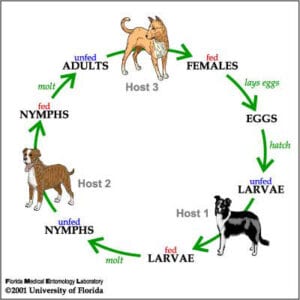How to Avoid the Un-Invited Houseguest This Summer
It appears that spring has finally sprung. The grass is green, days are longer, and the breeze is warmer. We are getting outside more, planning summer trips, baseball games, pools, etc. All the joys of summer means that fleas and ticks are also here, and they want in.
Let’s talk about the life cycle of the flea. I would like you to imagine a summertime rainstorm. You’re driving along on a sunny day and suddenly a black cloud dumps rain on you for only a few moments. Now imagine being on a plane above that storm cloud, watching it leave a trail of water while everywhere else is dry. That’s what happens when an animal with fleas walks around.
“But my pet only goes outside for a few moments a day!” Really? So do we in many situations, and we still get bit by bugs. Parasites are opportunistic, they wait for your pet to walk past and BAM, they hitch a ride.
Flea eggs are constantly falling off the animal in a random pattern as they move about. The more an animal stays in one spot, the more that area becomes infested with flea eggs. A female flea can lay 500-1000 eggs during her lifetime. So, mom lays her eggs, which hatch in about 4 days, and for the next two weeks, the larvae (maggots) develop through three stages. The larvae will then spin a cocoon and stay dormant in the pupae stage until the next dog or cat comes along, and the cycle starts all over again. All of this has happened at a microscopic level in the fibers of your carpet, furniture, bedding, cracks in the floors, etc. and you will never see it happen.

So what about ticks? Ticks go through multiple stages of development and will feed on one host, fall off, develop into the next life stage and then find a new host to feed on. In North Carolina we deal with multiple species of ticks, the most notable are Ixodes (deer tick), Dermacentor variabilis (American dog tick), Rhipicephalus (brown dog tick), and Amblyomma (gulf coast tick). Female ticks can lay hundreds of eggs and infect areas quickly.

How can we prevent our pets from flea and tick exposure? If they go outside, you can’t. Fencing around your yard keeps some critters out, but not all of them. Unfortunately, without prevention there is a good chance eventually your pet will end up with fleas and/or ticks. There are many options for flea and tick prevention, way too many to name here. But in general, there are monthly tablets, chewable tablets taken every three months, monthly applications, and collars. Your veterinarian can advise you on an appropriate, safe product for your cat or dog. Overall, my conversation about flea and tick prevention with my clients involves a few important bullet points:
- Flea and tick baths are pointless. If your pet has fleas/ticks on them, there are thousands in the environment, and as soon as your pet dries, the fleas/ticks have a clean place to live.
- The find-and-pull off method risks your pet of contracting one of the potentially fatal tick diseases we see in this area, such as Lyme, Rocky Mountain Spotted Fever, Ehrlichiosis, Babesiosis, Tick Paralysis.
- There is no Dollar Store remedy. Low cost flea and tick products are often products that have long lost their ability to control parasites well. That’s why they are cheaper. The older products are often not as safe. By saving a few dollars on a cheap product you will often spend double that dealing with the fleas and ticks in your environment and treating your pet for the subsequent diseases.
- Always be sure that you are using the appropriate products labeled for your pet. Many products for dogs are dangerous, and possibly life threatening, to your cat. Don’t try to split products between multiple pets.
- And finally, if you are using high quality flea/tick prevention, you are NOT using a repellant. The flea or tick WILL get on your pet, come in contact with the product, and either become sterile or die, depending on the product. A tick control was successful if the tick you find on your pet is small and dead. Ticks must first attach themselves to your pet in order to feed. The goal of a tick product is to kill the tick before it starts to feed, which is when disease transfer can occur.
- It is also important to note, if you have a flea problem in your environment, it can take up to three months or longer to get rid of all them. Seeing a small flea or two on the belly of your dog or cat during this time is normal.
DISCLAIMER: ANY INFORMATION PROVIDED ON THIS SITE IS FOR EDUCATIONAL PURPOSES ONLY AND SHOULD NOT BE A SUBSTITUTE FOR PROFESSIONAL MEDICAL ADVICE, DIAGNOSIS, OR TREATMENT. GENERALIZED CASES AND SCENARIOS DO NOT APPLY TO EVERY PET. ALWAYS CHECK WITH YOUR OWN VETERINARIAN BEFORE USING ANY INFORMATION OR ADVICE PROVIDED HERE, OR TRYING ANY TREATMENTS ON YOUR OWN. ANY COMMENTS OR RESPONSES MADE ON THIS BLOG DO NOT CONSTITUTE A VALID CLIENT-PATIENT-DOCTOR RELATIONSHIP. RELYING ON INFORMATION PROVIDED BY THIS SITE IS SOLELY AT OUR OWN RISK.
